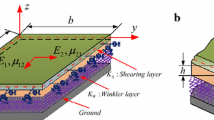Abstract
Plates are common structural elements of most engineering structures, including aerospace, automotive, and civil engineering structures. The study of plates from theoretical perspective as well as experimental viewpoint is fundamental to understanding of the behavior of such structures. The dynamic characteristics of plates, such as natural vibrations, transient responses for the external forces and so on, are especially of importance in actual environments. In this paper, we conside the envelope surface created by the vibrations of a square plate on a weakly nonliner elastic foundation and analyze the stability of the uniform solution of the governing equation for the envelope surface. We derive the two-dimensional equation that governs the spatial and temporal evolution of the envelope surface on cubic nonlinear elastic foundation. The fact that the governing equation becomes the quintic nonlinear Schrödinger equation is shown. Also we obtain the stability condition of the uniform solution of the quintic nonlinear Schrödinger equation.
Similar content being viewed by others
References
S.P. Timoshenko, Theory of Plates and Shells. McGraw-Hill, New York, 1940.
S.P. Timoshenko and S. Woinowsky-Krieger, Theory of Plates and Shells McGraw-Hill, Singapore, 1970.
A.C. Ugural, Stresses in Plates and Shells. McGraw-Hill, New York, 1981.
A.W. Leissa, Vibration of Plates. NASA-Sp-160, 1969.
H.N. Chu and G. Herrmann, Influence of large amplitudes on free flexural vibrations of rectangular elastic plates. Journal of Applied Mechnics,23 (1956), 532–540.
M.M. Hrabok and T.M. Hrudey, A review and catalog of plate bending finite elements. Computers and Structures,19 (1984), 479–495.
R.C. Averill and J.N. Reddy, Behavior of plate elements based on the first-order shear deformation theory. Engineering Computations,7 (1990), 57–74.
J.N. Reddy, An Introduction to the Finite Element Method, second edition. McGraw-Hill, New York, 1993.
R. Haberman, Elementary Applied Partial Differential Equations. Prentice Hall, Englewood Cliff, NJ, 1983.
Y. Goda, Numerical experiments on wave statistics with spectral simulation. Report Port Harbour Research Institute,9 (1970), 3–57.
S.K. Chakrabarti, R.H. Snider and P.H. Feldhausen, Mean length of runs of ocean waves. Journal of Geophysical Research,79 (1974), 5665–5667.
M.S. Longuet-Higgins, Statistical properties of wave groups in a random sea-state. Philosophical Transactions of the Royal Society of London, Series A,312 (1984), 219–250.
H. Washimi and T. Taniuti, Propagation of ion-acoustic solitary waves of small amplitude, Physics Review Letters,17 (1966), 996–998.
G.P. Agrawal, Fiber-Optic Communication System, second edition. Wiley, New York, 1997.
B.T. Nohara, Governing equations of envelope surface created by directional, nearly monochromatic waves. Journal of Society of Industrial and Applied Mathematics,13 (2003), 75–86, (in Japanese).
B.T. Nohara, Derivation and consideration of governing equations of the envelope surface created by directional, nearly monochromatic waves. International Journal of Nonlinear Dynamics and Chaos in Engineering Systems,31 (2003), 375–392.
B.T. Nohara, Governing equations of envelope surface created by nearly bichromatic waves, Propagating on an Elastic Plate and Their Stability. Japan Journal of Industrial and Applied Mathematics,22 (2005), 87–109.
B.T. Nohara and A. Arimoto, The stability of the governing equation of envelope surface created by nearly bichromatic waves propagating on an elastic plate. Nonlinear Analysis,63 (2005), 2197–2208.
B.T. Nohara, A. Arimoto and T. Saigo, Governing equations of envelopes created by nearly bichromatic waves and relation to the nonlinear Schrödinger equation. Chaos, Soliton and Fractals, 2006, to appear.
B.T. Nohara and T. Saigo, Numerical simulations of the envelope created by nearly bichromatic waves. Proceeding on COMSOL Multiphysics Conference, Boston, USA, October 23–25, 2005, 383–386.
M.A. Zarubinskaya and W.T. van Horssen, On the vibration on a simply supported square plate on a weakly nonlinear elastic fooundation. International Journal of Nonlinear Dynamics and Chaos in Engineering Systems,40 (2005), 35–60.
A.H. Nayfeh, Perturbation Methods. Wiley, New York, 2002.
A.H. Nayfeh and D.T. Mook, Nonlinear Oscillations. Wiley, New York, 1979.
T.B. Benjamin and J.E. Feir, The disintegration of wavetrains on deep water, Part 1, Theory. Journal of Fluid Mechnics,27 (1967), 417–430.
Author information
Authors and Affiliations
Corresponding author
About this article
Cite this article
Nohara, B.T., Arimoto, A. On the quintic nonlinear Schrödinger equation created by the vibrations of a square plate on a weakly nonlinear elastic foundation and the stability of the uniform solution. Japan J. Indust. Appl. Math. 24, 161–179 (2007). https://doi.org/10.1007/BF03167530
Received:
Revised:
Issue Date:
DOI: https://doi.org/10.1007/BF03167530




